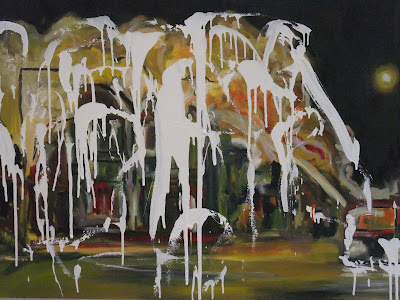Blue 1
When I started making Blue 1 I used a photo, which showed detail of a building, rather than a broad view of the destruction of the riots. I think it is more interesting the less a viewer might know about the scene. If I was to crop the top of the buildings and the sky, the painting could work in a more abstract way. I may try taking a small part of the original image to make more paintings.
With regard to colour, Blue 1, initially had a ground colour of red/orange. I then painted with variations of blue, I could not control the urge to use a bit of yellow and green. I used a metal scraper to remove some of the layers of paint revealing some of the ground colour. There is a ghostly, desolate atmosphere to the painting and I'm sure colour has emphasized the sense of the destroyed, burnt out buildings.
Blue 2
I based this painting on 'Croydon's Burning 1' (below), which I made using colours similar to those in the original image, I wanted to see how different colours could affect image. Blue 2 is partly of the same image however I chose to use cold blue's for this painting, does it still feel like fire? Perhaps its because of 'Croydon's Burning' that 'Blue 2' still depicts a sense of fire and destruction for me, regardless of the colour. What does this do for my work? Well, what I do know is that it has clarified for me that I like the ambiguity in 'Blue2', the flames and burning buildings on the right hand side of the painting are undoubtedly visible to me, however a viewer might be totally oblivious to the fact that this is a painting based on fire and destruction. The viewer may not immediately notice the no entry signs or the fire hose across the bottom of 'Blue 2', and actually this is, for me, important that the audience has to think about the work. In contrast, the painting below, is a more obvious depiction which has no challenge for the audience.

Croydon's Burning - 1
Blue 3
Blue 3 is work in progress, I decided to make a painting based on the feeling of 'Riots in Blue' not sure where this is going but its all part of my journey.




































